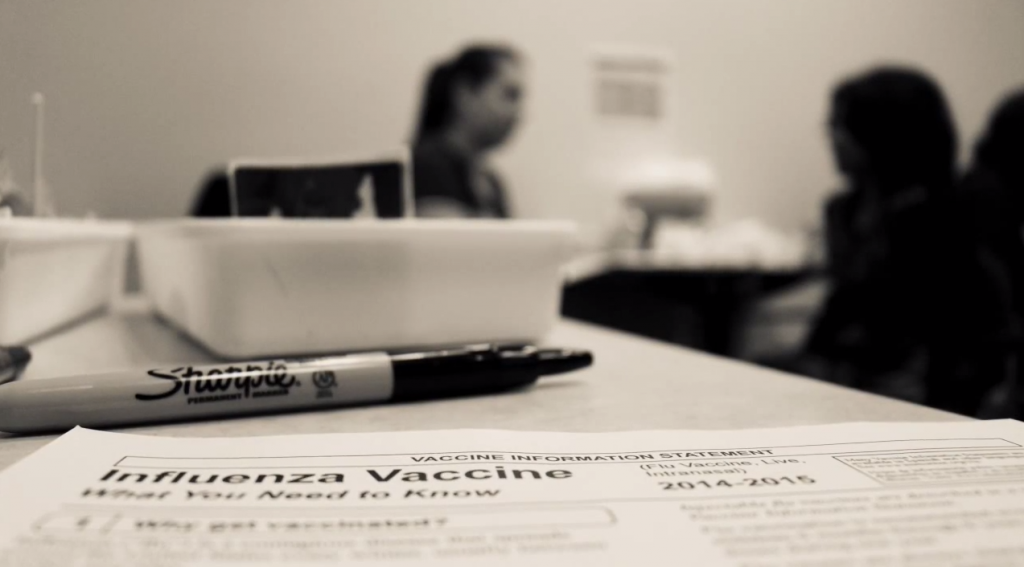In public remarks about Ebola and Islamic terrorism last month, President Obama brought up another threat — the flu.
“If people want to make sure that as we go into the holiday season their families are safe, the very best thing they can do is make sure that everybody in the family is getting a flu shot. Because we know that tens of thousands of people will be affected by the flu this season, as is true every season,” Obama said.
In Palo Alto, doctors are hoping that a new government recommendation that children aged two through eight receive a nasal spray immunization will lead more to get their children vaccinated.
Biopharmaceutical company AstraZeneca is distributing 15 million doses of its nasal spray flu vaccine FluMist Quadrivalent, one million doses more compared to last year. Palo Alto Medical Foundation (PAMF) purchased about 25,000 doses of FluMist for PAMF patients this year compared to only 10,000 doses last year.
The 2014-2015 flu season marks the first time the Centers for Disease Control and Prevention (CDC) has recommended the nasal spray vaccine over the shot, after clinical trials showed children have a stronger immune response to the nasal-spray vaccine. Although the FluMist vaccine is only recommended over the shot for those aged two through eight, it is effective for healthy individuals up to age 49.
The term LAIV, which stands for Live Attenuated Influenza Vaccine, marks one of the biggest differences between the nasal spray and shot vaccinations. The nasal spray vaccination, which requires the participant to sniff .1 mL of mist through each nostril, is a live virus. Though alive, the virus is weakened to the point where it cannot give someone the flu. The needle administered flu shots, on the other hand, are made with inactivated dead viruses, or sometimes, with no flu vaccine viruses at all.
In each circumstance, doctors emphasize the side effects of the flu vaccination are almost always mild. “It is impossible to get the flu from the flu shot,” Weiss said. For the shot, typical side effects include soreness in the arm and a headache.
“This year the shot really had a punch to it,” said Genia Lezotte, a nurse administering vaccinations in the Palo Alto Medical Foundation’s walk-in flu clinic, who received the shot herself.

But with interest in the FluMist nasal spray on the rise, doctors hope that the needleless allure of the vaccination will get more people into local clinics.
“[The best part about the FluMist] is that you don’t get hurt,” said 10-year-old Lucy Leff, who watched her mother Mary Beth Leff get the nasal spray after she got it herself. “The shot hurts. The nasal spray is better because you don’t have to get a Band-Aid.”
“It feels like a reverse sneeze,” said Mary Beth, who grabbed butterfly stickers for her daughters on the way out of the clinic.
Although the height of flu season isn’t until January and February, medical professionals stress the importance of getting vaccinated before then.
“As scary as the disease is, influenza is a far bigger problem,” Weiss said. The CDC reports there are upwards of 200,000 hospitalizations due to the influenza virus per year.“It has a major effect on the health of U.S. population,” Weiss said.
Yet even with the severity of the flu widely publicized, medical professionals face perennial challenges convincing the public to get vaccinated.
“It is hard to convince people even with science,” said Diane Slavin-low, a nurse in the Palo Alto Medical Foundation flu clinic. “People get stuck in their ways and don’t want to change.”
One such non-believer in the flu vaccine is Jennifer Schmid. Schmid, a nurse, is also the CEO of a Santa Clara-based company called Oasis Wellness, which consults with and educates patients about getting healthy in natural ways. These ways include managing diets, sleep patterns and exercise routines.
“I am not a big fan of the flu vaccine,” Schmid said. “We are a society of the quick-fix instead of one that makes the personal investments to take care of our own bodies.” Schmid notes that flu season is also when people are eating the most sugar during holidays, not getting as much vitamin D because there is less sunlight and exercising less because of the cold outdoors. For Schmid, these problems can all be remedied through diet and lifestyle changes that strengthen the immune system instead of through a vaccination.
According to the CDC, only 39.5 percent of people six months and older had been vaccinated as of this time last year. Weiss agrees that a misunderstanding of the flu vaccination is at the root of many who choose not to get immunized.
